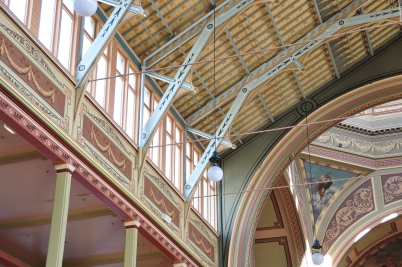Australia in the nineteenth century was a very different place from now. These days Australians take most of their cultural cues from America, and have done since the end of the Second World War. However in an earlier time, many Australians prided themselves on being more British than the British. Right up into the 20th century, decades after Australia had federated and become (semi) independent, it was common for people to consider themselves to be British, despite never having left Australia.
In the late nineteenth century, this probably wasn’t an unreasonable way of feeling about things. Britain ruled large chunks of the world and had planted anglophone colonies in a variety of unusual and inhospitable places. British science and technology set the pace and everyone else was trying to keep up. This was epitomised by the Great Exhibition in London in 1851, and its centrepiece, the Crystal Palace. This giant contraption of iron and glass was a technical marvel, even though it later (implausibly, for a metal building) burned down. The Exhibition showcased the cultures and products of the world, and brought them to the British public at an affordable price. Queen Victoria herself visited multiple times. Thus the exhibition movement was born – a combination of trade fair, international one-upmanship, and the exercise of soft power.
1851 also marked the discovery of gold in the British colony of Victoria, turning the grotty provincial capital of Melbourne into a bluestone and gilt marvel in almost no time. Vast quantities of gold were mined and spilled over into every aspect of life in Melbourne. Barely 20 years old, Melbourne was transformed into one of the leading cities of the Empire, rivalling Dublin, Edinburgh and Cape Town. Naturally the government of Victoria wanted to mark Melbourne’s entry into the big time – so they planned an exhibition and built a structure to house it.

I’ve lived in Melbourne most of my life and I must have gone past the Royal Exhibition Building hundreds of times. Yet it’s only recently that I’ve been organised enough to go inside and have a look. It’s a grand building, certainly. The partially gilded dome can be seen for miles around, and it’s set in a large European-style park which keeps up the illusion of a transplanted England. The nearby Melbourne Museum runs tours and my group was shown around by two guides, both named Phil. As you’d imagine, they were comically dissimilar. Tours are only available when there are no current exhibitions, and since the World Heritage nomination relies (in part) on the ongoing use of the structure for its original purpose, I suppose that’s reasonable.
Stepping inside the front door, there are two surprises. The first is how incredibly light the space is. There are enormous segmented windows on all sides which illuminate every corner. Here again the cues were taken from the Crystal Palace. The Royal Exhibition Building was the site of the proclamation of Australia’s Federation, and apparently one of these beams of light illuminated the Duke of York at the pivotal moment. This was duly painted into the official portraits of the occasion.
The second surprise is that the entire structure, bar the foundations, is made of wood and brick. Knowing something of the history of the Exhibition movement, I imagined that iron would be the material of choice, especially since the building is so clearly modelled on the Crystal Palace. I wasn’t able to get an answer as to why iron wasn’t used, but I suspect it was due to the limited industrial capacity of the colony. If nothing else, the colony’s main source of coal was hundreds of miles away and was yet to be connected by rail.
The lack of iron in construction means that the roof is made of large timbers painted with (what seem to me to be) Baltic designs. It looks weirdly flimsy. The interior of the building has been repainted numerous times, but currently matches what would have been current at the time of Federation in 1901. Salmon and Brunswick Green everywhere.
Structural spaces on the walls are decorated with paintings of Greek Sylphs, representing the times and seasons. Apparently they used to show more flesh, but some time after the original artwork was done, the puritanical instincts of the Australian public demanded diaphanous gowns to be overlaid on bare flesh. There are also a series of small ceramic cameos attached to the walls below the sylphs, which represent the various racial archetypes present within the British Empire. Light pours in from the dome which has another series of frescoes. One amused me in particular – each Australian state is represented by a woman and perennial rivals Victoria and New South Wales are shaking hands while Queensland looks on. Poor Queensland, forever the bridesmaid. The other states have been relegated to the corner as unimportant.

The UNESCO World Heritage listing is based on this site representing the international Exhibition movement, which I guess it does. But there’s no doubt in my mind that if the Crystal Palace still existed, I wouldn’t be writing this. There may also be an element of interstate rivalry happening, as the Sydney Opera House is Sydney’s contribution to the world. I think that as a nomination it’s a little flimsy, but far from the flimsiest that I’ve seen
Nevertheless it was a pleasure to finally be able to get inside the building. I suspect that much of my enjoyment relies on knowing about the history of the place, as for some overseas visitors it might just be a large building that vaguely resembles a church.




One thought on “The Crystal Palace, transplanted (sort of)”